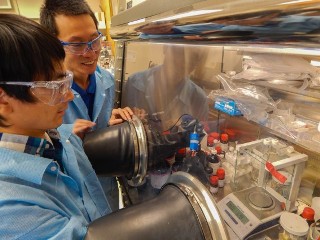Nov 6 2015
The performance of lithium ion batteries (LIBs) has been improved by using graphene nanofoam electrodes that have been treated with hydrogen. The hydrogen treatment results in hole-formation in the defective graphene resulting in a more porous electrode.
 From left, LLNL postdoc Jianchao Ye works on a lithium ion battery, while Morris Wang looks on. The two are part of a team studying the use of hydrogen for longer-lasting batteries. Photos by Julie Russell
From left, LLNL postdoc Jianchao Ye works on a lithium ion battery, while Morris Wang looks on. The two are part of a team studying the use of hydrogen for longer-lasting batteries. Photos by Julie Russell
LIBs are a type of rechargeable battery. When LIBs are charged the lithium ions move from the positive to the negative electrode, with the reverse occurring during discharging.
The need for energy storage is growing day by day, and this raises the requirement for batteries of higher performance. The performance of a lithium ion battery is dependent upon several characteristics including voltage, energy density and capacity.
The binding between the electrode material and the lithium ions determines these characteristics. The strength of the bond between lithium ions and an electrode can be affected by even the smallest of changes in the shape, chemistry and structure of the electrodes.
The team at the Lawrence Livermore National Laboratory (LLNL) found that LIBs that used graphene nanofoam electrodes treated with hydrogen demonstrated faster transport and higher capacity.
These findings provide qualitative insights in helping the design of graphene-based materials for high-power electrodes
Morris Wang - LLNL
The popularity of LIBs is increasing, and they are used widely in aerospace and electric vehicles. Traditionally, lead acid batteries have been used for utility vehicles and golf carts. These are being replaced by LIBs as they can provide the same voltage whilst being much lighter than the lead plates and they do not require the acid electrolytes.
The ability to economically produce large quantities of graphene will determine if this new method can be used on a commercial scale for the production of energy storage devices such as supercapacitors and lithium ion batteries.
When graphene is chemically synthesized an excess of atomic hydrogen is left behind. It has not been possible to determine the effects that the hydrogen has on the electrochemical performance of graphene derivatives.
The calculations and experiments carried out as part of the research revealed that when defect-rich graphene was intentionally treated with hydrogen at a low-temperature, it enhances the rate capacity of the graphene.
During this hydrogen treatment an interaction takes place between atomic hydrogen and the graphene defects. This results in the formation of small gaps, which enable lithium to be able to penetrate the electrode more rapidly.
Enhanced lithium binds near the edges where there is more possibility of hydrogen binding. This provides additional capacity in terms of reversiblity.
The performance improvement we’ve seen in the electrodes is a breakthrough that has real world applications.
Jianchao Ye - LLNL
The team then studied the role of hydrogen and hydrogenated defects in graphene’s lithium storage ability. The researchers exposed the material to hydrogen under different heat conditions. They observed the way in which the 3D graphene nanofoam (GNF) electrodes performed electrochemically.
These 3D GNF electrodes are mostly made of defective graphene, and they could be used in a wide range of applications including LIBs, supercapacitors, catalysis, energy sorbents, insulators, filters or as hydrogen storage systems and capacitive desalinators.
Graphene 3D foam has a binder-free nature that makes it suitable for mechanistic studies as complications that may be caused by additives cannot occur.
We found a drastically improved rate capacity in graphene nanofoam electrodes after hydrogen treatment. By combining the experimental results with detailed simulations, we were able to trace the improvements to subtle interactions between defects and dissociated hydrogen. This results in some small changes to the graphene chemistry and morphology that turn out to have a surprisingly huge effect on performance.
Brandon Wood - LLNL
The study reveals that controlled hydrogen treatment could help optimize the transport of lithium and reversible storage in other materials that are based on graphene.
The research paper has been published in the journal, Nature Scientific Reports.